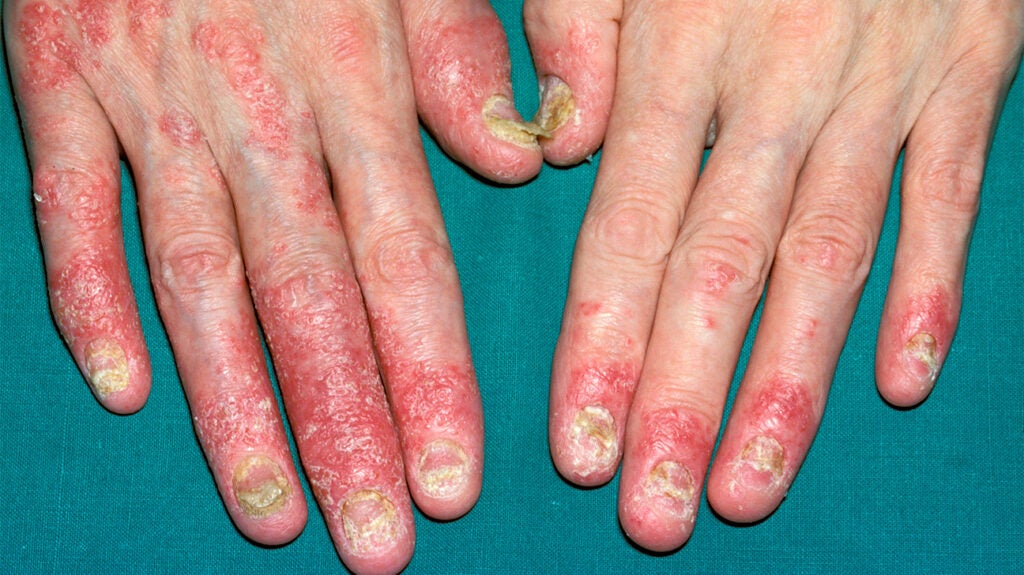Psoriatic arthritis (PsA) is a chronic autoimmune condition affecting approximately 30% of individuals with psoriasis, characterized by joint pain, stiffness, and swelling. Typically, PsA is associated with elevated inflammation markers like C-reactive protein (CRP) or erythrocyte sedimentation rate (ESR), which aid in diagnosis and treatment monitoring. However, a significant subset of patients experience psoriatic arthritis without inflammation markers, posing unique challenges in diagnosis and management. This article explores the complexities of this condition, its diagnostic hurdles, treatment approaches, and strategies to improve outcomes for patients.
Understanding Psoriatic Arthritis
PsA is classified as a seronegative spondyloarthropathy, meaning it typically lacks autoantibodies like rheumatoid factor, distinguishing it from rheumatoid arthritis (RA). It presents in varied forms, including peripheral joint involvement, axial (spine) disease, enthesitis (inflammation where tendons or ligaments attach to bones), and dactylitis (swelling of entire fingers or toes). Psoriasis, marked by scaly skin patches, usually precedes or coexists with PsA, though joint symptoms can appear first in about 15% of cases.

Inflammation markers like CRP and ESR are elevated in 50–70% of PsA patients, reflecting systemic inflammation. However, psoriatic arthritis without inflammation markers occurs in up to 40% of cases, as noted in a 2023 study in Arthritis Research & Therapy. This absence complicates diagnosis, delays treatment, and underscores the need for alternative diagnostic tools and tailored management strategies.
Read more: Dietary Approaches in the Management of Diabetic Patients with Kidney Disease
Why Inflammation Markers May Be Normal
Several factors explain why some PsA patients have normal CRP or ESR levels:
-
Disease Variability: PsA is heterogeneous, and patients with early-stage disease, enthesitis-dominant PsA, or axial involvement may not exhibit systemic inflammation detectable by standard tests.
-
Localized Inflammation: PsA often involves focal inflammation (e.g., in joints or entheses) rather than widespread systemic inflammation, which may not elevate biomarkers.
-
Non-Inflammatory Symptoms: Joint pain may stem from mechanical issues, osteoarthritis, or fibromyalgia-like symptoms, which do not trigger inflammation markers but mimic PsA.
-
Genetic Factors: Variations in immune pathways may result in active PsA without elevating CRP or ESR, as certain genetic profiles produce less systemic inflammation.
-
Medication Effects: Treatments like nonsteroidal anti-inflammatory drugs (NSAIDs) or disease-modifying antirheumatic drugs (DMARDs) may suppress biomarker levels while symptoms persist.
Understanding these factors is critical for clinicians to avoid dismissing active disease in patients with normal blood tests.
Diagnostic Challenges
Diagnosing psoriatic arthritis without inflammation markers is challenging because clinicians often rely on elevated CRP or ESR to confirm inflammation and differentiate PsA from conditions like osteoarthritis, fibromyalgia, or gout. Key obstacles include:
-
Symptom Overlap: Joint pain, stiffness, and fatigue are common to multiple conditions, making it hard to pinpoint PsA without objective markers.
-
Risk of Misdiagnosis: Normal biomarkers may lead clinicians to question inflammation, potentially misdiagnosing PsA as a non-inflammatory condition.
-
Delayed Treatment: Without clear biomarkers, diagnosis may be delayed, increasing the risk of joint damage, reduced mobility, and diminished quality of life.

To overcome these challenges, clinicians employ a multifaceted approach:
-
CASPAR Criteria: The Classification Criteria for Psoriatic Arthritis (CASPAR) include psoriasis (current, past, or family history), nail dystrophy, dactylitis, negative rheumatoid factor, and radiographic evidence of new bone formation near joints. These criteria are effective even without elevated markers.
-
Imaging Techniques: Ultrasound or MRI can detect synovitis, enthesitis, or erosions not visible on X-rays, confirming PsA in the absence of biomarkers.
-
Clinical Evaluation: A detailed history and physical exam, focusing on patterns like asymmetric joint involvement, enthesitis, or dactylitis, are crucial for diagnosis.
Read more: Navigating Hearing Aid Insurance: Costs, Coverage, and Savings Strategies
Treatment Approaches
Managing psoriatic arthritis without inflammation markers requires a tailored approach, as normal biomarkers do not necessarily indicate mild disease. Treatment aims to reduce symptoms, prevent joint damage, and improve quality of life. Key strategies include:
-
Nonsteroidal Anti-Inflammatory Drugs (NSAIDs): Ibuprofen or naproxen can relieve mild joint pain and stiffness but may not address underlying disease progression.
-
Disease-Modifying Antirheumatic Drugs (DMARDs): Methotrexate or leflunomide are used for moderate to severe PsA to slow joint damage, even in patients with normal biomarkers.
-
Biologics: Tumor necrosis factor inhibitors (e.g., adalimumab, etanercept) or IL-17 inhibitors (e.g., secukinumab) target specific inflammatory pathways and are effective for PsA, particularly when joint or skin symptoms persist despite normal markers. A 2024 study in The Lancet Rheumatology found biologics improved outcomes in 70% of PsA patients with normal CRP.
-
Corticosteroids: Low-dose steroids may be used sparingly for flare-ups, but long-term use is avoided due to side effects.
-
Physical Therapy: Exercise and physical therapy improve joint mobility and reduce stiffness, tailored to the patient’s physical capacity.
-
Lifestyle Modifications: Weight management (aiming for a BMI of 18.5–24.9) and a Mediterranean diet rich in anti-inflammatory foods (e.g., fish, olive oil, vegetables) can reduce symptoms and cardiovascular risk, a major concern in PsA.
Monitoring and Follow-Up
Without inflammation markers to gauge disease activity, monitoring relies on:
-
Symptom Tracking: Patients should record pain, stiffness, and fatigue levels using tools like the Psoriatic Arthritis Impact of Disease (PsAID) questionnaire.
-
Imaging Follow-Ups: Regular ultrasounds or MRIs can assess joint or entheseal inflammation, guiding treatment adjustments.
-
Multidisciplinary Care: Rheumatologists, dermatologists, and physical therapists should collaborate to address both joint and skin symptoms.
Patient Strategies for Coping
Patients with psoriatic arthritis without inflammation markers can take proactive steps to manage their condition:
-
Education: Learn about PsA through reputable sources like the National Psoriasis Foundation or Arthritis Foundation to understand symptoms and advocate for care.
-
Symptom Journaling: Track symptoms, triggers (e.g., stress, diet), and medication responses to share with healthcare providers.
-
Support Networks: Join support groups, in-person or online, to connect with others facing similar challenges. The Psoriasis and Psoriatic Arthritis Alliance offers resources and community forums.
-
Mental Health: Chronic pain and diagnostic uncertainty can impact mental health. Mindfulness, counseling, or stress-reduction techniques can help.
Challenges and Solutions
-
Diagnostic Uncertainty: Normal biomarkers may lead to skepticism from clinicians or patients. Solution: Seek a rheumatologist experienced in PsA for a thorough evaluation using CASPAR criteria and imaging.
-
Treatment Hesitancy: Patients may question the need for aggressive treatment without elevated markers. Solution: Discuss imaging results and long-term risks of untreated PsA, such as joint erosion, to justify therapy.
-
Access to Care: Biologics and specialist visits can be costly. Solution: Explore patient assistance programs through pharmaceutical companies or non-profits like the Patient Access Network Foundation.
The Future of PsA Management
Emerging research is improving our understanding of psoriatic arthritis without inflammation markers. Advances in imaging, such as high-resolution ultrasound, and biomarkers like IL-17 or IL-23 levels may enhance diagnostic accuracy. Precision medicine, tailoring treatments to genetic or immune profiles, holds promise for personalized care. Advocacy efforts by groups like the National Psoriasis Foundation are also pushing for better insurance coverage and access to biologics, addressing barriers for PsA patients.
Practical Tips for Patients
-
Partner with Specialists: Work with a rheumatologist and dermatologist to develop a comprehensive treatment plan.
-
Stay Active: Engage in low-impact exercises like swimming or yoga to maintain joint function without exacerbating symptoms.
-
Monitor Symptoms: Use apps like MyPsoriasis or ArthritisPower to track symptoms and share data with your doctor.
-
Explore Financial Aid: Check insurance coverage for biologics or apply for co-pay assistance through drug manufacturers.
-
Build a Support System: Connect with local or online PsA communities for emotional and practical support.
Conclusion
Psoriatic arthritis without inflammation markers presents unique challenges, from diagnostic delays to treatment uncertainties. By leveraging clinical criteria, advanced imaging, and tailored therapies, patients and clinicians can effectively manage this condition. With proactive strategies, including lifestyle changes, symptom tracking, and collaboration with specialists, individuals can mitigate symptoms, protect joint health, and improve quality of life. As research advances, the future holds promise for more precise diagnostics and treatments, empowering those with PsA to live fuller, healthier lives.


.jpg)










